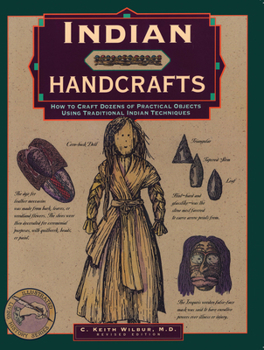Indian Handcrafts
Select Format
Select Condition 
Book Overview
Indian Handcrafts explains how each object evolved, how it was used, and what tools and materials you need to re-create it.
Format:Paperback
Language:English
ISBN:0762706619
ISBN13:9780762706617
Release Date:January 2001
Publisher:Globe Pequot Press
Length:144 Pages
Weight:0.95 lbs.
Dimensions:0.4" x 8.5" x 11.0"
Related Subjects
Activities, Crafts & Games Americas Arts & Crafts Biographies Children's Children's Books Crafts Crafts & Hobbies Crafts & Hobbies Education & Reference Engineering Industrial, Manufacturing & Operational Systems Literature & Fiction Multicultural Native American Native American Studies Politics & Social Sciences Social Science Social Sciences Specific Demographics Sports & Hobbies TechnologyCustomer Reviews
3 ratings
Great Factual Information
Published by Thriftbooks.com User , 16 years ago
Indian Handcrafts by C. Keith Wilbur is a great primer for people who actually want to MAKE items in the manner that native Americans. There are countless illustrations in here showing you exactly what the item looks like - in many cases drawn direction from historical artifacts located in museums (which are named). So if you really want to go see the arrowhead, or the rubbing stick, you can literally take a trip out to the named museum and see the actual artifact for yourself. It's important to note that while this book simply claims to have "Indian Handcrafts", they are ALL from the northeast US area - primarily Massachusetts, Connecticut and Rhode Island. This isn't a bad thing at all, but they should more clearly identify that on the front of the book. There are a ton of crafts NOT mentioned in here, because they weren't practiced by the tribes in this area. Also, for example when they talk about gardening like a native, and list out the foods that you should grow, the list is: corn, beans, pumpkins, squash, jerusalem artichokes, ground cherries, gourds and tobacco. This is a great list for Massachusetts, and certainly *similar* to what they grew in Florida or Arizona, but it is again important to know that this is a regional summary. The book is good about both providing a "super 100% authentic" way of doing things - but also giving you shortcuts if you wish. As the author notes, native Americans were very quick to adapt new technologies when they encountered them. When they met up with people who had easy access to metal, they took those metals and melted them down rather than going through the labor intensive trouble of making their own metals from scratch. When they met up with people who had pretty glass beads, they didn't spend weeks and weeks hand grinding stones down into bead shapes. So in the same manner, sure, you are provided with instructions for hand making dyes from plants and flowers. But if you want, you can also use commercial dyes. This is not really "cheating" - it is efficient, and the natives were efficient where they had access to those supplies. The book is also cautious in its environmental impact. Yes, the natives would strip birch bark off of trees to use it for various crafts. However, in modern times we do not have huge forests of birch - and stripping off birch bark would kill the trees. We can't afford to kill off trees just for "fun crafts". The author gives you ways to get your hands on the ingredients in a more environmentally friendly manner. Keith was apparently 67 when he published this book in 1990, and you can see his lifetime of research clearly here. He talks about the different ways he practiced making stone tools, tried carving out canoes, and much more. This is a man who actually learned how to do these crafts and is now sharing his knowledge. I really appreciate that! The drawings are very detailed. I still wish, though, that they used a "regular font" for reading, instead of the calligraphy-st
Excellent source of projects for school or scouting
Published by Thriftbooks.com User , 24 years ago
I have used this book to instruct boy scouts in Native American and early New England craft with great success. The broad range of projects can easily provide you with a year's worth of activities that fit perfectly within the scouting program. The sketches and instuctions are easy to follow and the required materials are not expensive.
Deep insight into Native American material culture
Published by Thriftbooks.com User , 26 years ago
This book describes many of the material goods made by Native Americans, and gives the reader an intimate understanding of their construction. Each item is described, with drawings of museum-piece examples. Wilbur then describes how Native Americans made the item (drawing from eye-witness memoirs where possible), and finally describes ways to make reproductions using modern techniques. Really gives one an appreciation for iron. Ideal for a youngster interested in Indians (and what youngster isn't?)




